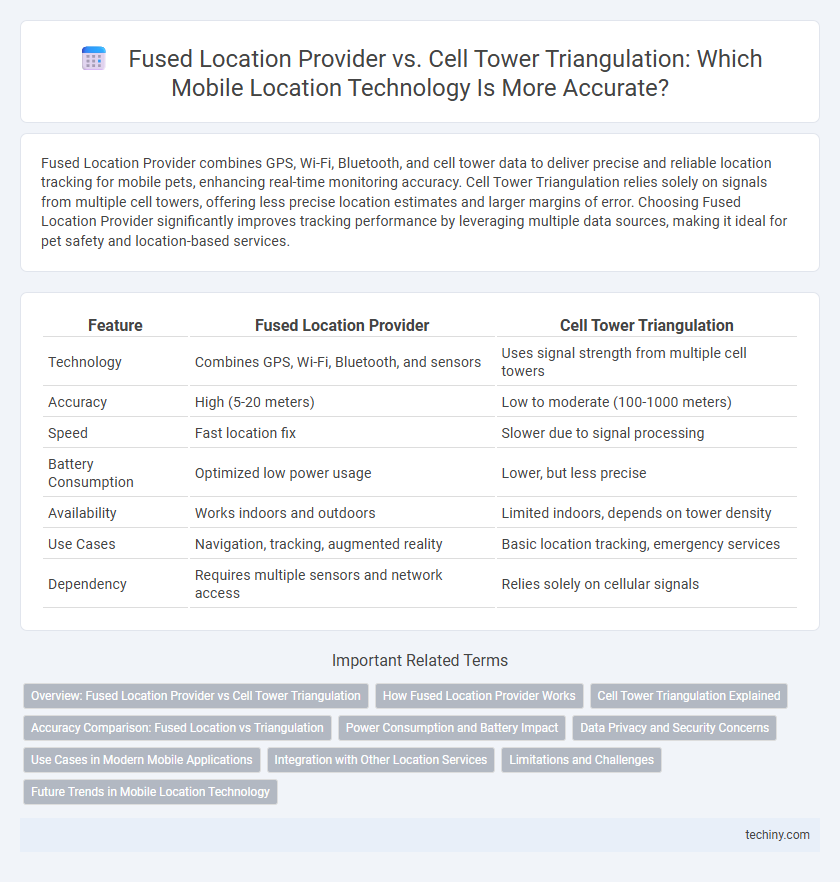Fused Location Provider combines GPS, Wi-Fi, Bluetooth, and cell tower data to deliver precise and reliable location tracking for mobile pets, enhancing real-time monitoring accuracy. Cell Tower Triangulation relies solely on signals from multiple cell towers, offering less precise location estimates and larger margins of error. Choosing Fused Location Provider significantly improves tracking performance by leveraging multiple data sources, making it ideal for pet safety and location-based services.
Table of Comparison
| Feature | Fused Location Provider | Cell Tower Triangulation |
|---|---|---|
| Technology | Combines GPS, Wi-Fi, Bluetooth, and sensors | Uses signal strength from multiple cell towers |
| Accuracy | High (5-20 meters) | Low to moderate (100-1000 meters) |
| Speed | Fast location fix | Slower due to signal processing |
| Battery Consumption | Optimized low power usage | Lower, but less precise |
| Availability | Works indoors and outdoors | Limited indoors, depends on tower density |
| Use Cases | Navigation, tracking, augmented reality | Basic location tracking, emergency services |
| Dependency | Requires multiple sensors and network access | Relies solely on cellular signals |
Overview: Fused Location Provider vs Cell Tower Triangulation
Fused Location Provider combines data from GPS, Wi-Fi, Bluetooth, and cell towers to deliver highly accurate and efficient location tracking on mobile devices. Cell Tower Triangulation estimates device position by measuring signal strength and time delay from multiple cellular towers, offering broader coverage but less precision. The Fused Location Provider's multi-sensor fusion enhances reliability and battery efficiency compared to the more limited and less precise cell tower triangulation method.
How Fused Location Provider Works
The Fused Location Provider combines data from GPS, Wi-Fi, Bluetooth, and cell towers to deliver highly accurate and efficient location estimates. It uses sensor fusion algorithms that weigh signals based on their reliability and power consumption, optimizing the balance between precision and battery life. By integrating multiple data sources, it outperforms traditional cell tower triangulation, which relies solely on signal strength from nearby towers for positioning.
Cell Tower Triangulation Explained
Cell Tower Triangulation is a geolocation method that estimates a device's position by measuring signal strength and timing from multiple cell towers. This technique uses the intersection of distance circles from at least three towers to determine the approximate location, making it less precise than GPS-based methods but effective in urban or rural areas with limited satellite visibility. The accuracy typically ranges from 50 meters to several kilometers, depending on tower density and signal quality.
Accuracy Comparison: Fused Location vs Triangulation
Fused Location Provider integrates GPS, Wi-Fi, Bluetooth, and cellular data to deliver highly accurate positioning, typically within a few meters. Cell Tower Triangulation relies on signal strength from multiple towers, resulting in less precise location data, often with accuracy ranging from several hundred meters to kilometers. The comprehensive data fusion in Fused Location Provider significantly outperforms the broader and less reliable estimates produced by Cell Tower Triangulation.
Power Consumption and Battery Impact
Fused Location Provider optimizes power consumption by combining GPS, Wi-Fi, and cell tower data to deliver accurate positioning with minimal battery drain, outperforming traditional Cell Tower Triangulation that relies heavily on cell signal strength and requires continuous tower communication. Cell Tower Triangulation often results in higher battery impact due to its reliance on multiple signal exchanges and less precise location estimates. Efficient use of sensor fusion in Fused Location Provider significantly extends device battery life while maintaining reliable location accuracy.
Data Privacy and Security Concerns
Fused Location Provider integrates GPS, Wi-Fi, and cell signals to enhance accuracy while offering stronger encryption methods, reducing data interception risks compared to traditional cell tower triangulation. Cell tower triangulation relies on signal strength from multiple towers, which can expose location data to unauthorized access due to less robust security protocols. Prioritizing encrypted channels and anonymized data in fused location services significantly mitigates privacy vulnerabilities inherent in basic triangulation methods.
Use Cases in Modern Mobile Applications
Fused Location Provider enhances accuracy and energy efficiency in modern mobile applications by combining GPS, Wi-Fi, and cell tower data, making it ideal for navigation, fitness tracking, and location-based services. Cell Tower Triangulation offers broader coverage with lower precision, suitable for emergency services, basic geofencing, and areas with limited GPS signals. Mobile apps leverage Fused Location Provider for real-time, high-precision location updates while relying on Cell Tower Triangulation for fallback positioning in challenging environments.
Integration with Other Location Services
Fused Location Provider integrates GPS, Wi-Fi, and sensor data to deliver highly accurate positioning, enhancing the overall location service ecosystem on mobile devices. Cell Tower Triangulation primarily depends on signals from multiple cell towers, offering broader but less precise location data suitable for basic tracking functions. Integration with other services like geofencing, activity recognition, and map applications is more seamless and reliable with Fused Location Provider due to its multi-source data fusion approach.
Limitations and Challenges
Fused Location Provider delivers high accuracy by combining GPS, Wi-Fi, and sensor data, yet it struggles in environments with obstructed satellite signals or limited network access, affecting precision. Cell tower triangulation offers broader coverage with lower power consumption but suffers from coarse accuracy and is heavily dependent on cell tower density, often resulting in less reliable location data in rural or indoor settings. Both methods face challenges related to privacy concerns, data latency, and the impact of environmental factors on signal quality.
Future Trends in Mobile Location Technology
Fused Location Provider technology integrates GPS, Wi-Fi, and sensor data to deliver highly accurate and energy-efficient positioning, surpassing traditional cell tower triangulation methods. Future trends point towards enhanced AI-driven algorithms and 5G connectivity, boosting real-time location precision and enabling complex applications like augmented reality and autonomous navigation. The convergence of multi-source data fusion with advanced network infrastructure will redefine mobile location accuracy and reliability in emerging smart city and IoT ecosystems.
Fused Location Provider vs Cell Tower Triangulation Infographic

 techiny.com
techiny.com